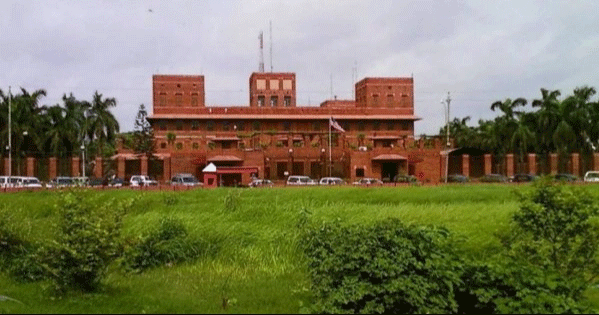River pollution puts fisheries at risk
Fishes die for toxic river water
Golam Mostafa Jibon: Fisheries are facing serious threat due to continuous grabbing and pollution of rivers located around Dhaka. Even in the rainy season, there is no availability of fishes in the rivers that growing tension among the concerned people. If necessary steps are not taken right now, fisheries in the country would face dire consequences in future, experts apprehended.
Sources said, the lifeblood of Dhaka is the Buriganga and all other rivers around it, while the life of the river is water. But, it is very painful that, the water of all rivers is being polluted alarmingly and the river is getting poisonous and lifeless.
As a result, fishes or aquatic animals can’t live in the poisonous water of the rivers. All the rivers situated around Dhaka have become poisonous seriously due to unbridle pollution from residential and industrial sources. There is no life in the rivers. The pollution is slowly becoming more widespread day by day putting the biodiversity at risk.
Environmentalists said, “The river pollution from Buriganga to Shitalakshya has now reached to the mouth of the Meghna that hampers Hilsa production drastically.
Meanwhile, the amount of Hilsa, popularly known as king of the fishes, has been decreased in the Meghna river as pollution of rivers around Dhaka is going on for long. If pollution is not prevented right now, the country’s fisheries will be threatened in the future, they opined.
Locals said, the river pollution is not being stopped at all despite the directives of High Court, protest, shouts and movements of environmentalists. The level of pollution is increasing day after day. The water of Buriganga and neighboring rivers has turned black due to contamination. Factory waste and garbage are floating in the river water. The stench is spreading from the river. Locals are at health risk.
During a recent visit, this correspondent found that, the water of Buriganga river has increased a lot due to the approach of monsoon. But, a strong stench was spreading from the water of the river due to continuous pollution. Garbage was seen floating in the water along the river banks at different places as huge quantity of garbage were dumped along the bank of the rivers.
Residential and industrial wastes are being dumped in the river regularly that making the water toxic.
Regarding the pollution of Buriganga, Abu Taleb, a fruit trader from Soarighat area said that, “At one time there were 12 water buses plying this route from Gabtali to Sadarghat. Currently there are only two. The main reason for stopping the water bus is less passengers. The reason for the low number of passengers is the stench of river water. No one wants to get on a water bus because of this horrible stink. Even those, who carry business near the banks of this river, can’t stand due to the stench for long. Now because of corona pandemic, I have worn a face mask. This is why, the smell is a bit less. Not only Buriganga, the situation of surrounding river-Turag, Balu, Shitalakshya and Dhaleshwari is same. The quality of water in these rivers is much lower than it should be to sustain aquatic life. The water quality in some areas improved for few days during the lockdown imposed by the government due to corona pandemic last year. But now, the situation has worsened further centering the ease of lockdown and rising of pollution.”
One of the criteria for measuring river pollution is the determination of Dissolved Oxygen (DO) in water. If there is a minimum of 5 mg DO per liter of water that water is considered to be of good quality. Observations of river quality by the Department of Environment over the last five years have shown that the amount of DO in the water of five rivers in Dhaka has dropped to zero in many places during the dry season.
In March this year, the DO level in the water near the Mirpur bridge of the Buriganga river was 0.32 percent. Here in April last year it was 2.2 percent. The DO near Gabtali bridge on Turag river was 1.2 percent last year. This time, it has come down to 5 percent.
According to the Department of Environment, the main source of pollution in Dhaka’s rivers is sewage. WASA can treat only 20 percent of the area and only 10 percent of human waste, while the rest falls into the river. The river is also getting polluted due to both the residential and industrial wastes.
The government agencies that are responsible for polluting the rivers are still busy blaming each other. The rivers of Dhaka are responsible for four major sources of pollution. These are industrial waste, sewage, solid waste of two cities and vessel waste. Multiple government agencies are responsible to look after and supervise the pollution.
The Department of the Environment said, “Pollution levels are increasing due to sewage.
Dhaka WASA Sewage Management Authority said, industrial waste pollution is on the rise. The Department of Environment is responsible to control it. Blame game is going on between them. But, no effective steps are being taken to prevent pollution. Shitalakshya near Dhaka is now ‘toxic’ due to continuous pollution. Some 417 Mills have been set up around Shitalakshya. Of which 105 factories do not have any waste treatment plant (ETP). As a result, the waste of these factories is dumped directly in water. Although, the remaining 312 factories have only nominal treatment plants, they do not use them and secretly or tactically dump the polluted waste in water.
Environmentalists said, the horrific water pollution of Shitalakshya has reached to the Meghna. As a result of spreading pollution in the water, the amount of Hilsa fish in Meghna is much less this time. If the pollution of the Meghna cannot be prevented now, Hilsa will not be found here in the future, let alone other aquatic animals. The condition of Meghna will be like Buriganga or Shitalakshya river.
According to a report by the Department of Environment, 4,500 tons of waste and 5.7 million gallons of polluted water are flowing into the rivers around the capital every day. Apart from this, industries are growing in Ashulia, Savar, New Leather Industry City and Tongi area outside the capital. Rapid industrialization is taking place on the banks of Karnafuli in Chattogram, next to Mawa Ghat in Padma, on the banks of Meghna. Most of these factories are not using waste treatment equipment, the report said. Prominent environmentalist and river researcher said.
River expert Dr. Ainun Nishat said that “There are rumors that various plans are being made to reduce river pollution in Dhaka. However, if the project is not accepted by all the concerned ministries, it will not be of any benefit. The money is being spent year after year in the name of the projects but no work is being done. If we do not work in a coordinated manner, it will not come to help. However, if river pollution is not prevented very quickly, our fisheries will face many disasters in the future. At the same time, biodiversity will be threatened. Due to pollution, the production of Hilsa in Meghna is decreasing day by day. Even in the Halda river, the only natural breeding center in the country, mother fish are not coming to lay eggs due to pollution. All in all, river pollution is leading us to a catastrophic catastrophe. This need to be seriously considered now and appropriate initiatives must be taken.”
Local Government, Rural Development and Cooperatives Minister Tajul Islam said, “A master plan has already been prepared for six rivers including Buriganga, Balu and Dhaleshwari to keep the river free from pollution and restore navigability. An agreement was reached with IWM and CEGIS on January 23 to carry out a master plan to prevent pollution of the Meghna.”
“According to the master plan being prepared, the concerned ministry will do the necessary work,” he added.
Syeda Rizwana Hasan, Chief Executive of the Bangladesh Environmental Lawyers Association (BELA) said, “The government has a constitutional responsibility to protect the river water bodies. But we see, our rivers have been poisoned from the stage of pollution and are now heading towards death. The death of the river means the loss of human drinking water, fish and aquatic life. In this case, the government has failed to fulfill its at least constitutional responsibility to protect the river.”
The government had spent tax money on river protection and shifted the tannery industry from Hazaribagh to Savar. But, the central waste treatment plant was not set up in the last two years. So another river is being polluted anew.
President Joe Biden tests positive for COVID-19 while campaigning in Las Vegas, has ‘mild symptoms’
International Desk: President Joe Biden tested positive for COVID-19 while traveling Wedne…








